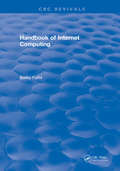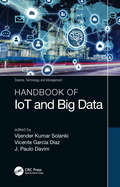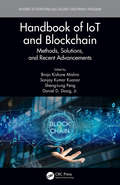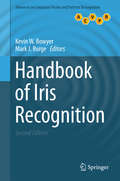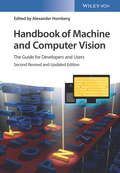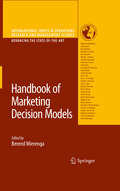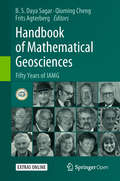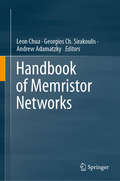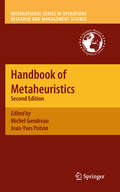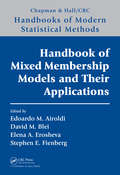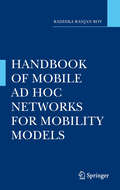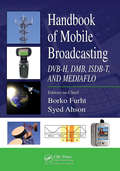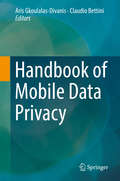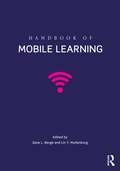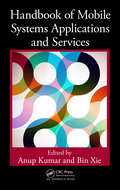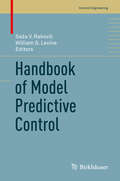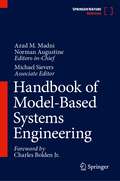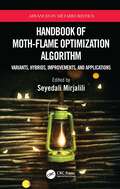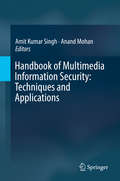- Table View
- List View
Handbook of Internet Computing (Internet And Communications Ser. #5)
by Borko FurhtScientists in different geographical locations conduct real-time experiments in a virtual shared workspace. E-commerce provides an emerging market for businesses large and small. E-mail, Servers, and Enterprise Resources Planning have revolutionized businesses on every level. People from all over the globe gather in chat rooms. The Internet is here to stay and Internet technologies and applications continue to grow and evolve.The Handbook of Internet Computing presents comprehensive coverage of all technical issues related to the Internet and its applications. It addresses hot topics such as Internet architectures, content-based multimedia retrieval on the Internet, Web-based collaboration, Web search engines, digital libraries, and more. Real-life examples illustrate the concepts so that technical, non-technical and business people can quickly grasp the fundamentals.
Handbook of IoT and Big Data (Science, Technology, and Management)
by J. Paulo Davim Vijender Kumar Solanki Vicente García DíazThis multi-contributed handbook focuses on the latest workings of IoT (internet of Things) and Big Data. As the resources are limited, it's the endeavor of the authors to support and bring the information into one resource. The book is divided into 4 sections that covers IoT and technologies, the future of Big Data, algorithms, and case studies showing IoT and Big Data in various fields such as health care, manufacturing and automation. Features Focuses on the latest workings of IoT and Big Data Discusses the emerging role of technologies and the fast-growing market of Big Data Covers the movement toward automation with hardware, software, and sensors, and trying to save on energy resources Offers the latest technology on IoT Presents the future horizons on Big Data
Handbook of IoT and Blockchain: Methods, Solutions, and Recent Advancements (Internet of Everything (IoE))
by Brojo Kishore Mishra, Sanjay Kumar Kuanar, Sheng-Lung Peng, and Daniel D. DasigHandbook of IoT and Blockchain: Methods, solutions, and Recent Advancements includes contributions from around the globe on recent advances and findings in the domain of Internet of Things (IoT) and Blockchain. Chapters include theoretical analysis, practical implications, and extensive surveys with analysis on methods, algorithms, and processes for new product development. IoT and Blockchain are the emerging topics in the current manufacturing scenario.This handbook includes recent advances; showcases the work of research around the globe; offers theoretical analysis and practical implications; presents extensive surveys with analysis, new contributions, and proposals on methods, algorithms, and processes; and also covers recent advances from quantitative and qualitative articles, case studies, conceptual works, and theoretical backing. This handbook will be of interest to graduate students, researchers, academicians, institutions, and professionals that are interested in exploring the areas of IoT and Blockchain.
Handbook of Iris Recognition
by Mark J. Burge Kevin BowyerThis authoritative collection introduces the reader to the state of the art in iris recognition technology. Topics and features: with a Foreword by the "father of iris recognition," Professor John Daugman of Cambridge University; presents work from an international selection of preeminent researchers, reflecting the uses of iris recognition in many different social contexts; provides viewpoints from researchers in government, industry and academia, highlighting how iris recognition is both a thriving industry and an active research area; surveys previous developments in the field, and covers topics ranging from the low-level (e.g., physics of iris image acquisition) to the high level (e.g., alternative non-Daugman approaches to iris matching); introduces many active and open areas of research in iris recognition, including cross-wavelength matching and iris template aging. This book is an essential resource for anyone wishing to improve their understanding of iris recognition technology.
Handbook of Iris Recognition
by Mark J. Burge Kevin W. BowyerThe definitive work on iris recognition technology, this comprehensive handbook presents a broad overview of the state of the art in this exciting and rapidly evolving field. Revised and updated from the highly-successful original, this second edition has also been considerably expanded in scope and content, featuring four completely new chapters. Features: provides authoritative insights from an international selection of preeminent researchers from government, industry, and academia; reviews issues covering the full spectrum of the iris recognition process, from acquisition to encoding; presents surveys of topical areas, and discusses the frontiers of iris research, including cross-wavelength matching, iris template aging, and anti-spoofing; describes open source software for the iris recognition pipeline and datasets of iris images; includes new content on liveness detection, correcting off-angle iris images, subjects with eye conditions, and implementing software systems for iris recognition.
Handbook of Logical Thought in India
by Sundar Sarukkai Mihir Kumar ChakrabortyThis collection of articles is unique in the way it approaches established material on the various logical traditions in India. Instead of classifying these traditions within Schools as is the usual approach, the material here is classified into sections based on themes ranging from Fundamentals of ancient logical traditions to logic in contemporary mathematics and computer science. This collection offers not only an introduction to the key themes in different logical traditions such as Nyaya, Buddhist and Jaina, it also highlights certain unique characteristics of these traditions as well as contribute new material in the relationship of logic to aesthetics, linguistics, Kashmir Saivism as well as the forgotten Tamil contribution to logic.
Handbook of Machine Learning Applications for Genomics (Studies in Big Data #103)
by Sanjiban Sekhar Roy Y. H. TaguchiCurrently, machine learning is playing a pivotal role in the progress of genomics. The applications of machine learning are helping all to understand the emerging trends and the future scope of genomics. This book provides comprehensive coverage of machine learning applications such as DNN, CNN, and RNN, for predicting the sequence of DNA and RNA binding proteins, expression of the gene, and splicing control. In addition, the book addresses the effect of multiomics data analysis of cancers using tensor decomposition, machine learning techniques for protein engineering, CNN applications on genomics, challenges of long noncoding RNAs in human disease diagnosis, and how machine learning can be used as a tool to shape the future of medicine. More importantly, it gives a comparative analysis and validates the outcomes of machine learning methods on genomic data to the functional laboratory tests or by formal clinical assessment. The topics of this book will cater interest to academicians, practitioners working in the field of functional genomics, and machine learning. Also, this book shall guide comprehensively the graduate, postgraduates, and Ph.D. scholars working in these fields.
Handbook of Machine and Computer Vision: The Guide for Developers and Users
by Alexander HornbergThe second edition of this accepted reference work has been updated to reflect the rapid developments in the field and now covers both 2D and 3D imaging. Written by expert practitioners from leading companies operating in machine vision, this one-stop handbook guides readers through all aspects of image acquisition and image processing, including optics, electronics and software. The authors approach the subject in terms of industrial applications, elucidating such topics as illumination and camera calibration. Initial chapters concentrate on the latest hardware aspects, ranging from lenses and camera systems to camera-computer interfaces, with the software necessary discussed to an equal depth in later sections. These include digital image basics as well as image analysis and image processing. The book concludes with extended coverage of industrial applications in optics and electronics, backed by case studies and design strategies for the conception of complete machine vision systems. As a result, readers are not only able to understand the latest systems, but also to plan and evaluate this technology. With more than 500 images and tables to illustrate relevant principles and steps.
Handbook of Marketing Decision Models
by Berend WierengaMarketing models is a core component of the marketing discipline. The recent developments in marketing models have been incredibly fast with information technology (e.g., the Internet), online marketing (e-commerce) and customer relationship management (CRM) creating radical changes in the way companies interact with their customers. This has created completely new breeds of marketing models, but major progress has also taken place in existing types of marketing models. Handbook of Marketing Decision Models presents the state of the art in marketing decision models. The book deals with new modeling areas, such as customer relationship management, customer value and online marketing, as well as recent developments in other advertising, sales promotions, sales management, and competition are dealt with. New developments are in consumer decision models, models for return on marketing, marketing management support systems, and in special techniques such as time series and neural nets.
Handbook of Mathematical Geosciences: Fifty Years of IAMG
by Frits Agterberg B.S. Daya Sagar Qiuming ChengThis Open Access handbook published at the IAMG's 50th anniversary, presents a compilation of invited path-breaking research contributions by award-winning geoscientists who have been instrumental in shaping the IAMG. It contains 45 chapters that are categorized broadly into five parts (i) theory, (ii) general applications, (iii) exploration and resource estimation, (iv) reviews, and (v) reminiscences covering related topics like mathematical geosciences, mathematical morphology, geostatistics, fractals and multifractals, spatial statistics, multipoint geostatistics, compositional data analysis, informatics, geocomputation, numerical methods, and chaos theory in the geosciences.
Handbook of Mathematical Induction: Theory and Applications (Discrete Mathematics and Its Applications)
by David S. GundersonHandbook of Mathematical Induction: Theory and Applications shows how to find and write proofs via mathematical induction. This comprehensive book covers the theory, the structure of the written proof, all standard exercises, and hundreds of application examples from nearly every area of mathematics.In the first part of the book, the author discuss
Handbook of Mathematical Methods in Imaging
by Otmar ScherzerThe Handbook of Mathematical Methods in Imaging provides a comprehensive treatment of the mathematical techniques used in imaging science. The material is grouped into two central themes, namely, Inverse Problems (Algorithmic Reconstruction) and Signal and Image Processing. Each section within the themes covers applications (modeling), mathematics, numerical methods (using a case example) and open questions. Written by experts in the area, the presentation is mathematically rigorous. The entries are cross-referenced for easy navigation through connected topics. Available in both print and electronic forms, the handbook is enhanced by more than 150 illustrations and an extended bibliography. It will benefit students, scientists and researchers in applied mathematics. Engineers and computer scientists working in imaging will also find this handbook useful.
Handbook of Memristor Networks
by Leon Chua Georgios Ch. Sirakoulis Andrew AdamatzkyThis Handbook presents all aspects of memristor networks in an easy to read and tutorial style. Including many colour illustrations, it covers the foundations of memristor theory and applications, the technology of memristive devices, revised models of the Hodgkin-Huxley Equations and ion channels, neuromorphic architectures, and analyses of the dynamic behaviour of memristive networks. It also shows how to realise computing devices, non-von Neumann architectures and provides future building blocks for deep learning hardware.With contributions from leaders in computer science, mathematics, electronics, physics, material science and engineering, the book offers an indispensable source of information and an inspiring reference text for future generations of computer scientists, mathematicians, physicists, material scientists and engineers working in this dynamic field.
Handbook of Metaheuristics (International Series in Operations Research & Management Science #146)
by Michel Gendreau and Jean-Yves PotvinThe rst edition of the Handbook of Metaheuristics was published in 2003 under the editorship of Fred Glover and Gary A. Kochenberger. Given the numerous - velopments observed in the eld of metaheuristics in recent years, it appeared that the time was ripe for a second edition of the Handbook. For different reasons, Fred and Gary were unable to accept Springer’s invitation to prepare this second e- tion and they suggested that we should take over the editorship responsibility of the Handbook. We are deeply honored and grateful for their trust. As stated in the rst edition, metaheuristics are “solution methods that orch- trate an interaction between local improvement procedures and higher level stra- gies to create a process capable of escaping from local optima and performing a robust search of a solution space. ” Although this broad characterization still holds today, many new and exciting developments and extensions have been observed in the last few years. We think in particular to hybrids, which take advantage of the strengths of each of their individual metaheuristic components to better explore the solution space. Hybrids of metaheuristics with other optimization techniques, like branch-and-bound, mathematical programming or constraint programming are also increasingly popular. On the front of applications, metaheuristics are now used to nd high-quality solutions to an ever-growing number of complex, ill-de ned re- world problems, in particular combinatorial ones.
Handbook of Mixed Membership Models and Their Applications (ISSN)
by Stephen E. Fienberg Edoardo M. Airoldi Elena A. Erosheva David M. BleiIn response to scientific needs for more diverse and structured explanations of statistical data, researchers have discovered how to model individual data points as belonging to multiple groups. Handbook of Mixed Membership Models and Their Applications shows you how to use these flexible modeling tools to uncover hidden patterns in modern high-dim
Handbook of Mixture Analysis (ISSN)
by Sylvia Frühwirth-Schnatter, Gilles Celeux and Christian P. RobertMixture models have been around for over 150 years, and they are found in many branches of statistical modelling, as a versatile and multifaceted tool. They can be applied to a wide range of data: univariate or multivariate, continuous or categorical, cross-sectional, time series, networks, and much more. Mixture analysis is a very active research topic in statistics and machine learning, with new developments in methodology and applications taking place all the time. The Handbook of Mixture Analysis is a very timely publication, presenting a broad overview of the methods and applications of this important field of research. It covers a wide array of topics, including the EM algorithm, Bayesian mixture models, model-based clustering, high-dimensional data, hidden Markov models, and applications in finance, genomics, and astronomy.Features: Provides a comprehensive overview of the methods and applications of mixture modelling and analysis Divided into three parts: Foundations and Methods; Mixture Modelling and Extensions; and Selected Applications Contains many worked examples using real data, together with computational implementation, to illustrate the methods described Includes contributions from the leading researchers in the field The Handbook of Mixture Analysis is targeted at graduate students and young researchers new to the field. It will also be an important reference for anyone working in this field, whether they are developing new methodology, or applying the models to real scientific problems.
Handbook of Mobile Ad Hoc Networks for Mobility Models
by Radhika Ranjan RoyThe Mobile Ad Hoc Network (MANET) has emerged as the next frontier for wireless communications networking in both the military and commercial arena. Handbook of Mobile Ad Hoc Networks for Mobility Models introduces 40 different major mobility models along with numerous associate mobility models to be used in a variety of MANET networking environments in the ground, air, space, and/or under water mobile vehicles and/or handheld devices. These vehicles include cars, armors, ships, under-sea vehicles, manned and unmanned airborne vehicles, spacecrafts and more. This handbook also describes how each mobility pattern affects the MANET performance from physical to application layer; such as throughput capacity, delay, jitter, packet loss and packet delivery ratio, longevity of route, route overhead, reliability, and survivability. Case studies, examples, and exercises are provided throughout the book. Handbook of Mobile Ad Hoc Networks for Mobility Models is for advanced-level students and researchers concentrating on electrical engineering and computer science within wireless technology. Industry professionals working in the areas of mobile ad hoc networks, communications engineering, military establishments engaged in communications engineering, equipment manufacturers who are designing radios, mobile wireless routers, wireless local area networks, and mobile ad hoc network equipment will find this book useful as well.
Handbook of Mobile Broadcasting: DVB-H, DMB, ISDB-T, AND MEDIAFLO
by Borko Furht Syed A. AhsonOperators are introducing mobile television and digital video content services globally. The Handbook of Mobile Broadcasting addresses all aspects of these services, providing a comprehensive reference on DVB-H, DMB, ISDB-T, and MediaFLO. Featuring contributions from experts in the field, the text presents technical standards and distribution proto
Handbook of Mobile Data Privacy
by Aris Gkoulalas-Divanis Claudio BettiniThis handbook covers the fundamental principles and theory, and the state-of-the-art research, systems and applications, in the area of mobility data privacy. It is primarily addressed to computer science and statistics researchers and educators, who are interested in topics related to mobility privacy. This handbook will also be valuable to industry developers, as it explains the state-of-the-art algorithms for offering privacy. By discussing a wide range of privacy techniques, providing in-depth coverage of the most important ones, and highlighting promising avenues for future research, this handbook also aims at attracting computer science and statistics students to this interesting field of research. The advances in mobile devices and positioning technologies, together with the progress in spatiotemporal database research, have made possible the tracking of mobile devices (and their human companions) at very high accuracy, while supporting the efficient storage of mobility data in data warehouses, which this handbook illustrates. This has provided the means to collect, store and process mobility data of an unprecedented quantity, quality and timeliness. As ubiquitous computing pervades our society, user mobility data represents a very useful but also extremely sensitive source of information. On one hand, the movement traces that are left behind by the mobile devices of the users can be very useful in a wide spectrum of applications such as urban planning, traffic engineering, and environmental pollution management. On the other hand, the disclosure of mobility data to third parties may severely jeopardize the privacy of the users whose movement is recorded, leading to abuse scenarios such as user tailing and profiling. A significant amount of research work has been conducted in the last 15 years in the area of mobility data privacy and important research directions, such as privacy-preserving mobility data management, privacy in location sensing technologies and location-based services, privacy in vehicular communication networks, privacy in location-based social networks, privacy in participatory sensing systems which this handbook addresses.. This handbook also identifies important privacy gaps in the use of mobility data and has resulted to the adoption of international laws for location privacy protection (e.g., in EU, US, Canada, Australia, New Zealand, Japan, Singapore), as well as to a large number of interesting technologies for privacy-protecting mobility data, some of which have been made available through open-source systems and featured in real-world applications.
Handbook of Mobile Learning
by Zane L. Berge Lin Y. MuilenburgThis handbook provides a comprehensive compendium of research in all aspects of mobile learning, one of the most significant ongoing global developments in the entire field of education. Rather than focus on specific technologies, expert authors discuss how best to utilize technology in the service of improving teaching and learning.
Handbook of Mobile Systems Applications and Services (Mobile Services And Systems Ser. #1)
by Bin Xie Anup KumarFrom fundamental concepts and theories to implementation protocols and cutting-edge applications, the Handbook of Mobile Systems Applications and Services supplies a complete examination of the evolution of mobile services technologies. It examines service-oriented architecture (SOA) and explains why SOA and service oriented computing (SOC) will pl
Handbook of Model Predictive Control (Control Engineering)
by Saša V. Raković William S. LevineRecent developments in model-predictive control promise remarkable opportunities for designing multi-input, multi-output control systems and improving the control of single-input, single-output systems. This volume provides a definitive survey of the latest model-predictive control methods available to engineers and scientists today. The initial set of chapters present various methods for managing uncertainty in systems, including stochastic model-predictive control. With the advent of affordable and fast computation, control engineers now need to think about using “computationally intensive controls,” so the second part of this book addresses the solution of optimization problems in “real” time for model-predictive control. The theory and applications of control theory often influence each other, so the last section of Handbook of Model Predictive Control rounds out the book with representative applications to automobiles, healthcare, robotics, and finance. The chapters in this volume will be useful to working engineers, scientists, and mathematicians, as well as students and faculty interested in the progression of control theory. Future developments in MPC will no doubt build from concepts demonstrated in this book and anyone with an interest in MPC will find fruitful information and suggestions for additional reading.
Handbook of Model-Based Systems Engineering
by Azad M. Madni Michael Sievers Norman AugustineThis handbook brings together diverse domains and technical competences of Model Based Systems Engineering (MBSE) into a single, comprehensive publication. It is intended for researchers, practitioners, and students/educators who require a wide-ranging and authoritative reference on MBSE with a multidisciplinary, global perspective. It is also meant for those who want to develop a sound understanding of the practice of systems engineering and MBSE, and/or who wish to teach both introductory and advanced graduate courses in systems engineering. It is specifically focused on individuals who want to understand what MBSE is, the deficiencies in current practice that MBSE overcomes, where and how it has been successfully applied, its benefits and payoffs, and how it is being deployed in different industries and across multiple applications. MBSE engineering practitioners and educators with expertise in different domains have contributed chapters that address various uses of MBSE and related technologies such as simulation and digital twin in the systems lifecycle. The introductory chapter reviews the current state of practice, discusses the genesis of MBSE and makes the business case. Subsequent chapters present the role of ontologies and meta-models in capturing system interdependencies, reasoning about system behavior with design and operational constraints; the use of formal modeling in system (model) verification and validation; ontology-enabled integration of systems and system-of-systems; digital twin-enabled model-based testing; system model design synthesis; model-based tradespace exploration; design for reuse; human-system integration; and role of simulation and Internet-of-Things (IoT) within MBSE.
Handbook of Moth-Flame Optimization Algorithm: Variants, Hybrids, Improvements, and Applications (Advances in Metaheuristics)
by Seyedali MirjaliliMoth-Flame Optimization algorithm is an emerging meta-heuristic and has been widely used in both science and industry. Solving optimization problem using this algorithm requires addressing a number of challenges, including multiple objectives, constraints, binary decision variables, large-scale search space, dynamic objective function, and noisy parameters. Handbook of Moth-Flame Optimization Algorithm: Variants, Hybrids, Improvements, and Applications provides an in-depth analysis of this algorithm and the existing methods in the literature to cope with such challenges. Key Features: • Reviews the literature of the Moth-Flame Optimization algorithm • Provides an in-depth analysis of equations, mathematical models, and mechanisms of the Moth-Flame Optimization algorithm • Proposes different variants of the Moth-Flame Optimization algorithm to solve binary, multi-objective, noisy, dynamic, and combinatorial optimization problems • Demonstrates how to design, develop, and test different hybrids of Moth-Flame Optimization algorithm • Introduces several applications areas of the Moth-Flame Optimization algorithm This handbook will interest researchers in evolutionary computation and meta-heuristics and those who are interested in applying Moth-Flame Optimization algorithm and swarm intelligence methods overall to different application areas.
Handbook of Multimedia Information Security: Techniques and Applications
by Amit Kumar Singh Anand MohanThis handbook is organized under three major parts. The first part of this handbook deals with multimedia security for emerging applications. The chapters include basic concepts of multimedia tools and applications, biological and behavioral biometrics, effective multimedia encryption and secure watermarking techniques for emerging applications, an adaptive face identification approach for android mobile devices, and multimedia using chaotic and perceptual hashing function. The second part of this handbook focuses on multimedia processing for various potential applications. The chapter includes a detail survey of image processing based automated glaucoma detection techniques and role of de-noising, recent study of dictionary learning based image reconstruction techniques for analyzing the big medical data, brief introduction of quantum image processing and it applications, a segmentation-less efficient Alzheimer detection approach, object recognition, image enhancements and de-noising techniques for emerging applications, improved performance of image compression approach, and automated detection of eye related diseases using digital image processing. The third part of this handbook introduces multimedia applications. The chapter includes the extensive survey on the role of multimedia in medicine and multimedia forensics classification, a finger based authentication system for e-health security, analysis of recently developed deep learning techniques for emotion and activity recognition. Further, the book introduce a case study on change of ECG according to time for user identification, role of multimedia in big data, cloud computing, the Internet of things (IoT) and blockchain environment in detail for real life applications. This handbook targets researchers, policy makers, programmers and industry professionals in creating new knowledge for developing efficient techniques/framework for multimedia applications. Advanced level students studying computer science, specifically security and multimedia will find this book useful as a reference.
